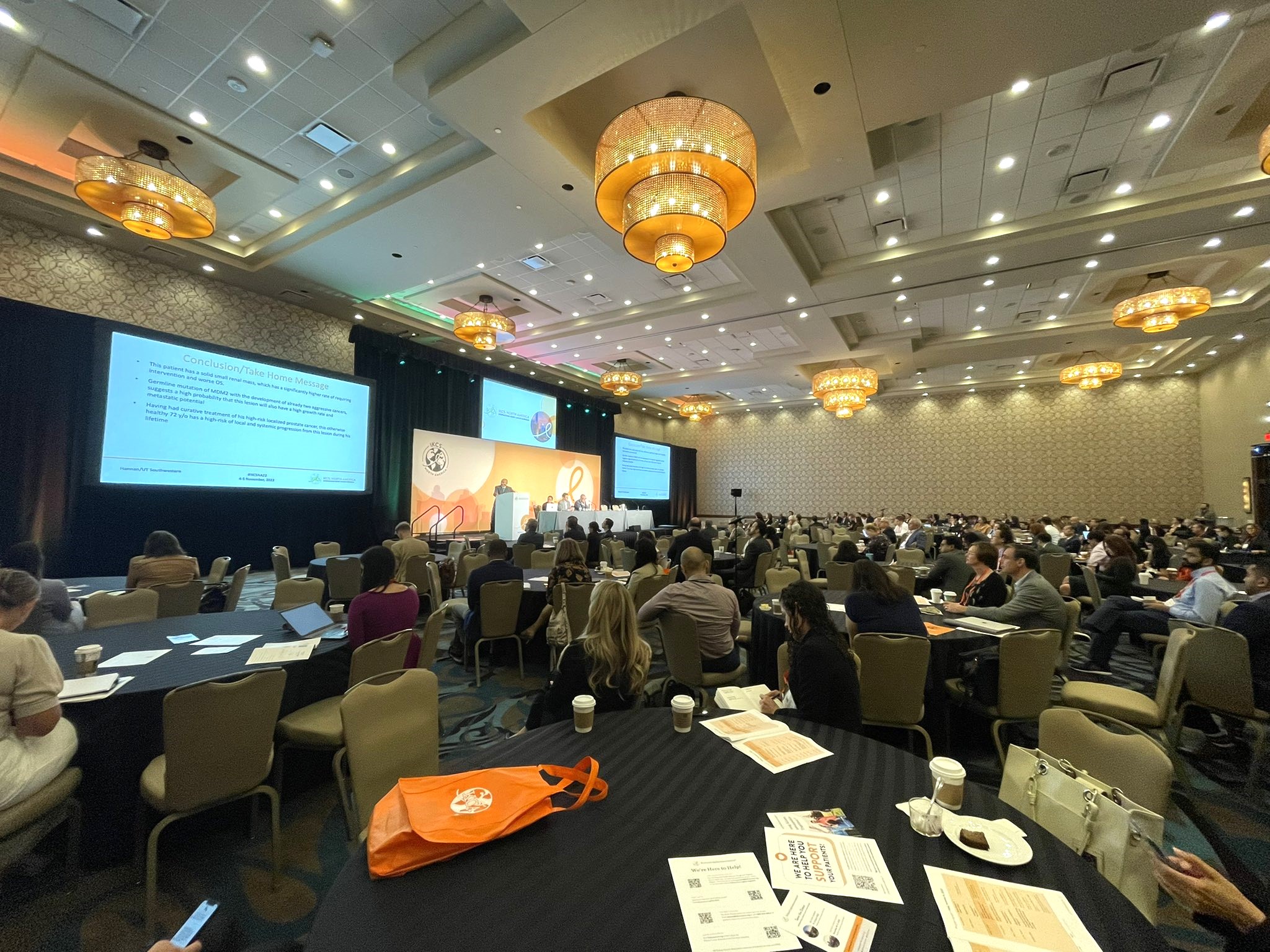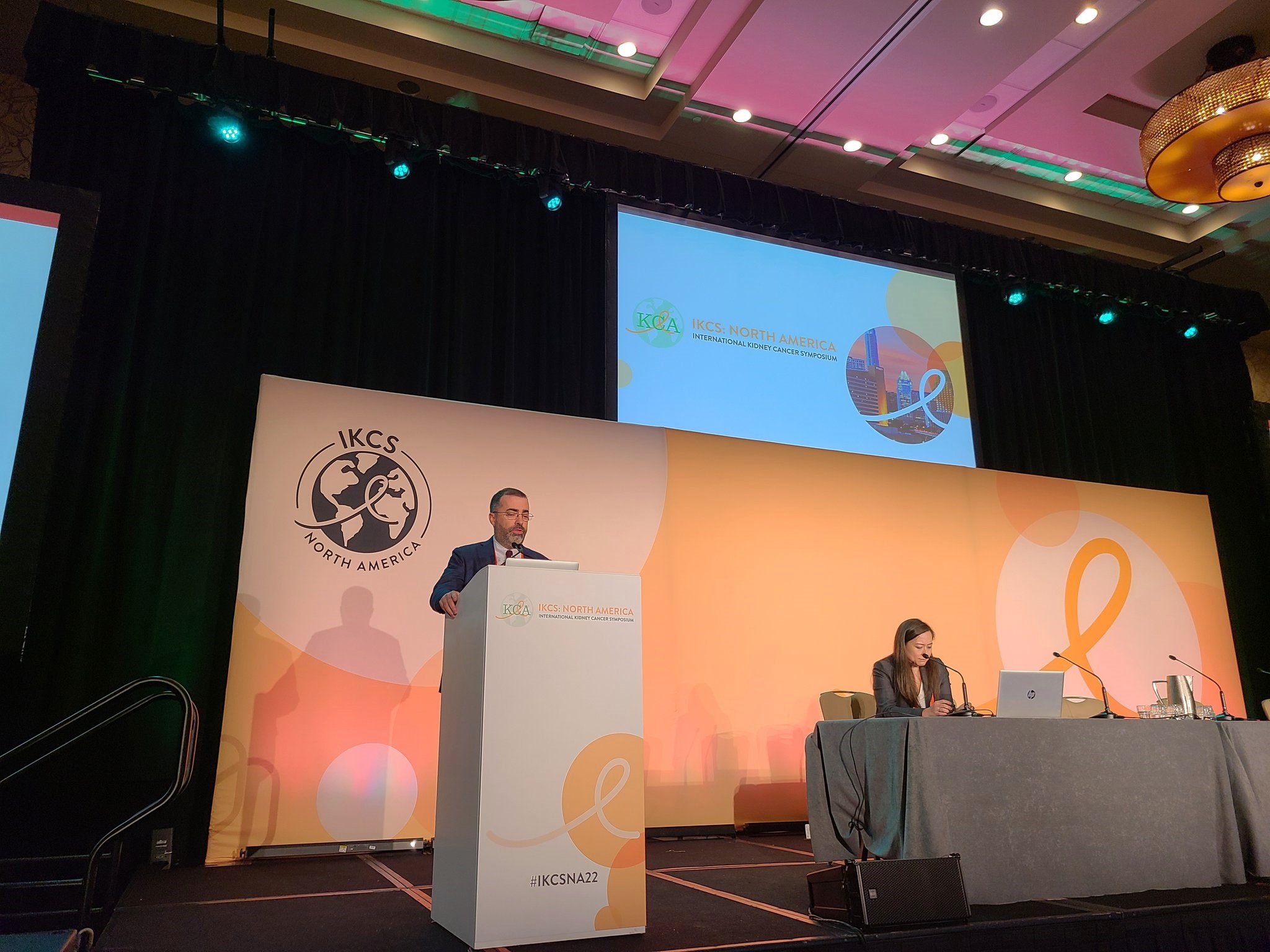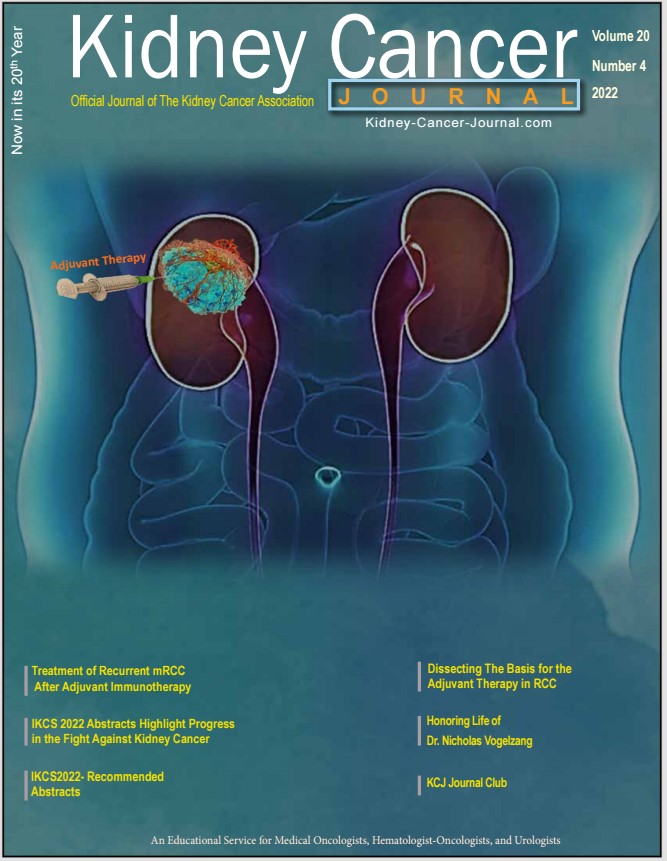Abstracts Highlight Progress in the Fight Against Kidney Cancer - IKCS 2022
Marc R. Matrana, MD, MS, FACPOchsner Medical Center, Ochsner Cancer Institute, New Orleans, LA 70121
ABSTRACT
The International Kidney Cancer Symposium (IKCS) took place in Austin, Texas November 4-5, 2022, providing an opportunity for kidney cancer researchers, clinicians, patients, and advocates to join together in-person and virtually to explore the latest science and emerging data in the fight again this dreaded disease. Here, we highlight key kidney cancer research updates presented at the meeting. Slides from the meeting’s presentations are available on the KCA-IKCS meeting website.
INTRODUCTION
The International Kidney Cancer Symposium
(IKCS) took place in Austin, Texas November
4-5, 2022, providing an opportunity for kidney
cancer researchers, clinicians, patients, and advocates
to join together in-person and virtually to explore the
latest science and emerging data in the fight against
this dreaded disease.

Dr. David McDermott served as the conference’s
keynote speaker in a session moderated by Dr. Tian
Zhang. Dr. McDermott’s talk, entitled “Making
Remissions More Common in Kidney Cancer,” began
with a focus on the rise of immunotherapies such as
IL-2, followed by a decline during the development
of targeted therapies, and the recent rise of
immunotherapies again with the develop of PD-1/PD-L1
inhibitors. He discussed the importance of appropriate
end-points in clinical trials, suggesting that “percent
surviving” may provide a clearer picture of both early
and late outcomes and a more robust measure of overall
success. He ended his talk with a review of strategies
being explored to increase immunotherapy effectiveness
and elicit more durable remissions in advanced kidney
cancers, including novel combination therapies, early
work on TIL therapies, novel targets, and vaccines.
A number of oral abstract presentations
illustrated knowledge around the basic biologic
mechanisms driving kidney cancer. For example,
Dr. Allison May presented an abstract that explored
the capacity of spatial molecular imaging (SMI)
to dissect the tumor immune microenvironment
(TiME) and epithelial to mesenchymal transition
EMT, specifically in sarcomatoid RCC. It is
thought that sarcomatoid renal cell carcinoma
(RCC) arises from other forms of the disease, most
commonly clear cell RCC via EMT. May and colleagues
spatially capture single cell level transcriptomic data
from a RCC sample from a responder to immunotherapy
and one from a non-responder. Forty fields of view
and over 100,000 single cells were captured. They
found significant differences in epithelial staining and
the immune microenvironment between clear cell
and sarcomatoid regions in the sample and unique
differences between the immunotherapy responder
and non-responder. Although the sample size of this
study is too small to draw definitive conclusions, it does
demonstrate the utility of this technique in sarcomatoid
RCC.
Gemma Davies presented an interesting study
of CD200, which along with its receptor CD200R is an
immunosuppressive checkpoint which contributes to
cancer cell immune evasion. These investigators found
that ccRCC CD200 expression contributes to immune
evasion by increasing Treg levels and causing activated
NK cell dysfunction, apoptosis, and decreased cytotoxic
response. They hypothesize that CD200:CD200R
checkpoint inhibition may be a potential novel
therapeutic target in ccRCC.

Other oral abstracts focused on advancing
clinical science of kidney cancer. Dr. Blum presented
a biomarker study of 18 patients with renal medullary
carcinoma (RMC), in which he and his colleagues
evaluated trends among several common biomarkers.
They found that the magnitude of both lactic
dehydrogenase (LDH) and CA-125 elevation was
directly proportional to the total metastatic burden,
and that CA-125 levels in widely metastatic patients
were more than 200% higher than upper-limit normal.
They concluded that biomarkers such as CA-125 may
assist in predicting development of metastatic disease,
trending treatment response or efficacy, identifying
new therapeutic targets in RMC.
Overly stringent clinical trial eligiblity criteria
create slow-accruing, lengthy, and expensive trials
whose data are not usually generalizable to larger
populations. A recent joint statement by the Friends
of Cancer Research (FCR) and the American Society of
Clinical Oncology (ASCO) has highlighted the need to
broaden eligibility criteria in cancer trials to increase
patient accrual and enhance the generalizability of
study results. Daniela Castro systemically reviewed
eligibility criteria in 423 RCC trials in the clinicaltrials.
gov database to assess this issue, finding 112 trials that
had enough publicly available data to be evaluable. She
found that hepatitis, concurrent malignancies, HIV,
and brain metastases were among the most frequently
cited exclusionary criteria in these studies, and that a
substantial proportion of RCC studies incorporated
exclusionary criteria deemed by the FCR-ASCO
statement to be potentially excessive.
Dr. Causa Andrieu presented a large database
study of 25,200 patients who underwent germline
analysis to investigate prevalence and features of
rare hereditary RCC, including Hereditary Papillary
Renal Carcinoma (HPRC), Birt-Hogg-Dube syndrome
(BHDS), BAP1 tumor predisposition syndrome (TPDS),
and Hereditary Paraganglioma/ Pheochromocytoma
syndrome (PGL/PCC). Prevalence of related gene
mutations were: MET: 1 mutation (with associated RCC)
out of 25,000 (0.004%); FLCN: 17/25000 (0.067%),
23.5% of which had RCC; BAP1: 22/25000 (0.087%),
18.2% with RCC; and SDH: 39/25000 (0.155%), 23.1%
with RCC.
Nazli Dizman presented the long-term follow-up
results of a randomized phase Ib trial of 29 patients with
metastatic RCC treated with nivolumab/ipilimumab
(nivo/ipi) with or without CBM588, a bifidogenic live
bacterial product. Overall response rate (ORR) was 20%
in the control arm and 58% in those receiving CBM588
in addition to immunotherapy. Disease control rate was
79% in the experimental arm, compared to 20% those
who did not receive CBM588. . Median progression free
survival (PFS) was 36.4 (95% CI 9.4-63.5) months in
the CBM588 arm versus 2.5 (95% CI 2.0-2.9) months
in those receiving nivolumab and ipilumumab without
CMB588. Median duration of response was 36.4 (95%
CI 20.6-52.2) months in the experimental arm versus
4.5 (95% CI NA-NA) in the control arm. Median overall
survival was not reached in either arm. The study
was limited by small sample size, but the impressive
results warrant further investigation of gut microbiome
modulation in patients receiving immunotherapy for
RCC.
Karie Runcie presented results of a trial
exploring the ideal timing of holding neoadjuvant
cabozantinib and nivolumab prior to nephrectomy,
evaluating the safety of 14 days vs 21 days between
discontinuation of cabozantinib and surgery. The
study concluded that the combination of cabozantinib
and nivolumab can be safely administered up to 14 days
prior to cytoreductive nephrectomy.
Ritesh Kotecha presented an analysis of
genetic ancestry and its molecular correlations within
subtypes of RCC. The study analyzed 953 patients and
found differences in histology, stage at presentation,
rate of poor-risk disease, and genetic alterations among
different ethnic groups. These researchers concluded
that population-specific variations do exists in patients
of different ancestry, however, it is challenging to
determine what role genetic and non-genetic (social
determinants of health for example) factors might play
into creating the disparities seen amongst populations.
In addition to oral abstract sessions, more than
45 abstracts were selected for poster presentations,
amongst these were abstracts that focused
on optimizing clinical aspects of kidney cancer
management. For example, Dr. Sven Lundstam
presented results of a study aimed at exploring the
development of end-stage renal disease (ESRD)
following treatment for RCC. They identified 215
patients with RCC and subsequent ESRD and compared
these to 9,299 patients with RCC without ERSD from
the National Swedish Kidney Cancer Register. The
incidence of ESRD after diagnosis of RCC was 2.5%,
ten times higher than in the control population. Radical
nephrectomy compared to partial nephrectomy or
tumor ablation was a significant risk factor during the
first year following surgery, while male sex, advanced
T-stage, diabetes, hypertension, chronic kidney disease
were significant risk factors over a 5 year period
following surgery.
Similar to exploring risk factors for ERSD
in RCC patients, it is equally important to be able to
predict which RCC are at higher risk for developing
cardiotoxicity. Dr. Hesham Yasin presented a project
that used artifacial intelligence (AI) to accurately predict
which RCC patients had the highest cardiotoxicity risk.
Dr. Yasin and colleagues suggested that integration of
such AI models into electronic medical records (EMR)
would assist physicians with identifying patients at
highest risk and allow for expedited, proactive referrals
for cardio-oncology treatment/monitoring.
Several abstracts explored various nuances
of cytoreductive nephrectomy (CN), including one
by Pranjal Agrawal that non-clear cell RCC histology
doesn’t negatively impact survival outcomes after CN
for metastatic RCC compared to clear cell RCC, and
another poster by the same author that showed inferior
vena cava (IVC) tumor thrombectomy with concurrent
CN is associated with surgical morbidity, but similar
survival as compared to who underwent CN without IVC
tumor thrombectomy. A poster by Dr. Andrew Hahn
explored CN in patients with metastatic sarcomatoid
and/or rhabdoid RCC who were treated with immune
checkpoint therapy. This study found that CN offered
no difference in immunotherapy treatment duration or
differences in survival.
A study presented by Dr. Kelly Fitzgerald
retrospectively analyzed 173 real-world patients
undering first line combination therapy for metastatic
clear cell RCC and found a significant difference in depth
of response between those receiving combinations
of two immunotherapies vs an immunotherapy and a
targeted-therapy. More objective responses were seen
in those receiving targeted-therapy based combinations
(65%) compared to immunotherapy-only combinations
(38%).
Several abstracts updated data from large
prospective trials, such as the Checkmate 214 study
which randomized patients to receive untreated
metastatic RCC patients to receive nivolumab and
ipilimumab versus sunitinib. At 60-months, treatment
free survival (TFS) for favorable-risk patients was
14.4 months in the combination arm 5.5 months in
the control arm, while TFS for intermediate/poor-risk
patients at 60-months was 10.1 vs. 4.1 months.
An updated analysis from the CLEAR trial
showed that metastatic ccRCC patients who completed 2
years of pembrolizumab combined with lenvatinib had
an overall survival rate of 94.5%. A long-term analysis
of the TIVO-3 study found that PFS was superior with
tivozanib compared to sorafenib in second and third
line metastatic RCC patients. Mean PFS rates were 12%
and 7.6% at 3 and 4-years for those receiving tivozanib
compared to 2% and 0% for those on the comparator
arms during the same time periods.
Finally, a poster presented by Dr. Stephen
Reese described features of NF2-mutated RCC, a lethal
unclassified form of kidney cancer, which metastasizes
early and is associated with a 18-month survival in this
cohort. A number of posters also described trials in
progress among other abstracts.
In summary, abstracts from IKCS 2022,
continued to show the diverse work being done around
the country and around the world in the fight against
kidney cancer.



